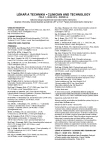-
Články
- Časopisy
- Kurzy
- Témy
- Kongresy
- Videa
- Podcasty
Individualization of head related transfer function
Head related transfer functions (HRTFs) are needed to present virtual spatial sound sources via headphones. Since individually measured HRTFs are very costly and time consuming, in this paper the individualization of the dummyhead’s HRTFs will be discussed. Here, the individualization is based on a scalable ellipsoidal head model. From this model the individualization is splitted into the individualization of the interaural time difference (ITD) and the spectral domain. The ellipsoidal modeling of the ITD gives quantitatively good results, considering the individual measurements. The second approach in spectral domain scales the transfer function in frequency. An angle dependent scaling factor is calculated by the head dimensions of the subject. Afterwards, the scaling results are compared and discussed with individual measurements.
Keywords:
binaural technology, virtual reality, HRTF
Autoři: Marcia Lins; Ramona Bomhardt
Působiště autorů: Institute of Technical Acoustics - RWTH Aachen University, Aachen, Germany
Vyšlo v časopise: Lékař a technika - Clinician and Technology No. 1, 2014, 44, 26-32
Kategorie: Původní práce
Souhrn
Head related transfer functions (HRTFs) are needed to present virtual spatial sound sources via headphones. Since individually measured HRTFs are very costly and time consuming, in this paper the individualization of the dummyhead’s HRTFs will be discussed. Here, the individualization is based on a scalable ellipsoidal head model. From this model the individualization is splitted into the individualization of the interaural time difference (ITD) and the spectral domain. The ellipsoidal modeling of the ITD gives quantitatively good results, considering the individual measurements. The second approach in spectral domain scales the transfer function in frequency. An angle dependent scaling factor is calculated by the head dimensions of the subject. Afterwards, the scaling results are compared and discussed with individual measurements.
Keywords:
binaural technology, virtual reality, HRTF
Zdroje
[1] Minaar, Pauli: Localization with binaural recordings from artificial and human heads, Journal of the Audio Engineering Society, Vol. 49 (2001), 323-336.
[2] Kuhn, George F.: Model for the interaural time differences in the azimuthal plane, The Journal of the Acoustical Society of America, Vol. 62 (1977), 157.
[3] Mechel, Fridolin P.: Formulas of Acoustics, Springer (2002), 189.
[4] Algazi, V. Ralph; Avendano, Carlos; Duda, Richard O.: Estimation of a spherical-head model from anthropometry, Journal of the Audio Engineering Society, Vol. 49 (2001), 472-479.
[5] Duda, Richard O.; Algazi, V. R.: An adaptable ellipsoidal head model for the interaural time difference, Acoustics, Speech, and Signal Processing (1999), IEEE, 965-968.
[6] Algazi, V. Ralph; Duda, Richard O.; Thompson, D. M.: The Cipic HRTF database, Applications of Signal Processing to Audio and Acoustics (2001), IEEE Workshop, 99-102.
[7] Middlebrooks, John C.,: Individual differences in external-ear transfer functions reduced by scaling in frequency, The Journal of the Acoustical Society of America, Vol.106 (1999), 1480.
[8] Middlebrooks, John C.: Virtual localization improved by scaling nonindividualized external-ear transfer functions in frequency, The Journal of the Acoustical Society of America (1999), 1480.
[9] Middlebrooks, John C.; Green, David M.: Sound localization by human listeners, Annual review of psychology, Vol. 42 (1991), 135-159.
[10] Blauert, Jens: Spatial Hearing: The Psychophysics of HumanSound Localization, MIT press (1997).
[11] Dietrich, P., Masiero, B., Vorländer, M.: On the Optimization of the Multiple Exponential Sweep Method, J. Audio Eng. Soc. 61.3 (2013), 113-124.
[12] Krechel, B.: Fast measurements of individual HRTFS using continuous mimo techniques, Institute for Technical Acoustics, Aachen (2012).
[13] Zillekens, S.: Measurement of individual HRTFs and postprocessing using spherical harmonics decomposition, Institute for Technical Acoustics, Aachen (2014).
[14] Almkvist, Gert; Berndt, Bruce (1988): Gauss, Landen, Ramanujan, The Arithmeticgeometric Mean, Ellipses, and the Ladies Diary. In: Amer Math. Monthly 95 (7), S. 585-608.
[15] Gellert, W.: Großes Handbuch der Mathematik, Buch und Zeit Verlagsgesellschaft Köln (1969).
[16] Blommer, Michael A.; Wakefield, Gregory H.: Pole-zero approximations for head-related transfer functions using a logarithmic error criterion, Speech and Audio Processing, IEEE, Vol. 5 (1997), 278-287.
[17] Dietrich, P., Guski, M., Pollow, M., Masiero, B., Müller-Trapet, M., Scharrer, R., and Vorländer, M. (2012). ITA-Toolbox - An Open Source MATLAB Toolbox for Acousticians. In DAGA 2012, 38. Jahrestagung f¨ur Akustik, 19. - 22. März 2012 in Darmstadt. Wiss / ed.: Holger Hanselka, pages 151-152. Deutsche Gesellschaft für Akustik e.V.
Štítky
Biomedicína
Článok vyšiel v časopiseLékař a technika

2014 Číslo 1-
Všetky články tohto čísla
- Rational operation of MRI equipment in university hospitals in the Czech Republic
- Individualization of head related transfer function
- Gene expression profiling after angiogenesis inhibitor treatment
- The effect of acetylsalicylic acid on angiogenesis in vitro
- The effect of docetaxel on molecular melting profile of DNA extracted from human breast adenocarcinoma MCF-7 cells
- Metalické nanočástice v prostředí terapeutického ultrazvuku – Studium viability nádorových buněk in vitro
- Metoda měření poddajnosti a těsnosti modelů respirační soustavy pacienta
- Lékař a technika
- Archív čísel
- Aktuálne číslo
- Informácie o časopise
Najčítanejšie v tomto čísle- Metoda měření poddajnosti a těsnosti modelů respirační soustavy pacienta
- Rational operation of MRI equipment in university hospitals in the Czech Republic
- Metalické nanočástice v prostředí terapeutického ultrazvuku – Studium viability nádorových buněk in vitro
- Individualization of head related transfer function
Prihlásenie#ADS_BOTTOM_SCRIPTS#Zabudnuté hesloZadajte e-mailovú adresu, s ktorou ste vytvárali účet. Budú Vám na ňu zasielané informácie k nastaveniu nového hesla.
- Časopisy



